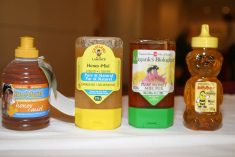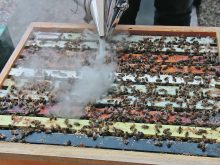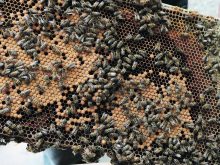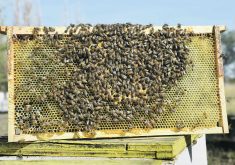U.S. fought honey fraud by imposing tariffs, which raised prices, while the Canadian sector pushes for increased testing
American and Canadian honey prices typically follow each other quite closely but now U.S. beekeepers are getting more.
As of Sept. 25, there was a 75 cents per pound gap between American and Canadian white canola honey prices as reported in the U.S. Department of Agriculture national honey report. It’s one of the largest price discrepancies in the last five years.
According to Rod Scarlett, president of the Canadian Honey Council, it’s partly due to U.S. tactics.
Read Also

Exports off to a slow start after last year’s torrid pace
Canadian grain, oilseed and pulse exports are off to a slow start, but there are some bright spots, according to the Canadian Grain Commission’s most recent weekly export data report.
“Mostly, I think it’s impacted by the U.S. packers and their reluctance to pay equivalent prices for premium Canadian honey,” he said, noting their desire to reduce supply costs.
The U.S. has a steady domestic supply and there has been less concern about honey colour in recent years. Simon Lalonde, a honey producer near Clavet, Sask., said U.S. honey packers began to change their narrative about honey colour in the early 2000s.
“Retailers started getting convinced by the U.S. packers that, ‘who cares what colour the honey is? As long as it says honey on the label, it shouldn’t matter what colour it is,’” he said.
Darker coloured honey is sold at a lower price. Less emphasis on colour led to higher volumes of cheaper, darker honey, which reduced demand for Canadian white honey.
It also set the stage for fraudulent honey, product mixed with syrups and other sugars, or “scrubbed” honey, from which pollen and antibodies are removed. Those products, often said to come from overseas, make their way into Canada and the U.S. at a much cheaper price point than domestically produced, pure honey.
“If you look at the retail shelves in the general U.S. stores, honey is actually, right now, quite dark,” Lalonde said.
U.S. packers aren’t even buying as much of their own American-produced honey, he added.
“They’re buying the cheapest honey they can get and putting it on the shelves.”
Until the U.S. experiences enough demand for imported honey of a certain quality, the “economic first” policy of the packers won’t change, Scarlett said. Canadian honey prices will rise when the “demand shortfall is there.”
Chris Hiatt, president of the American Honey Producers Association, said domestically produced honey previously made up 60 to 66 per cent of U.S. consumption. That has dropped to between 25 and 30 per cent.
Saturation of imported product on the U.S. honey market led American honey producers to push for an anti-dumping case against Vietnam, India, Argentina and Brazil, in addition to honey tariffs previously imposed against China. They came out on top of that dispute, and tariffs came into effect three years ago.
Hiatt says this influenced the rise in prices.
“After the dumping suit win, two, three years ago, we had record high honey prices. So that was great.”
Prices have since softened, which he said echoed results of similar trade actions taken against China in 2001.
While Canadian producers would like to see higher prices, they’re not going about it the same way as the U.S. Scarlett said tariffs and the accompanying “legal rigmarole” create their own issues, such as trans-shipped honey, as well as being expensive to administer.
Instead, the council is pushing for more honey testing to better identify pure honey and limit the amount of adulterated honey being imported.
“If there was a way to limit imports, it may impact pricing,” said Scarlett.
When honey is imported to Canada, it must be have papers of analysis or be tested. Canada has been testing for fraudulent honey for five years, and was the first country to do so, but fake honey still slips through the cracks.
In 2022, Canada imported 10,556 tonnes of honey. In 2023, the total was 7,405 tonnes.
The Canadian Food Inspection Agency’s Food Fraud Annual Report for 2022-23 found that 84 per cent of honey samples were satisfactory. Of the 16 per cent that failed to pass muster, all were from imported sources. Some 89.77 tonnes of honey were detained.
Those numbers encompass only a small number of tests, however. Across all food types, 767 samples were tested. That included only 82 honey samples: 20 domestic and 62 imported.
“What we’ve asked is the Canadian Food Inspection Agency increase the amount of testing on imported honey for honey fraud,” Scarlett said. “And I think we, as an industry, would be satisfied if the honey being imported was truly honey, but we have a strong belief that a vast majority of honey imported from certain countries is fraudulent.”
He said that, because honey blended with syrups is not a health issue, honey fraud is low on the CFIA’s priority list.
“The biggest thing is they just need funding to be able to do it, and funding is getting cut, it’s not getting added,” said Lalonde. “We have kind of started, fairly informally, amongst beekeepers trying to say, ‘hey, can we raise enough money with a possible levy or something like that on honey or on beehives, that could go towards authentication of these honeys coming in?’”
The suggestion of a levy, about one cent per pound of honey, has had a generally positive response. Lalonde said the ultimate goal would be to test all honey being imported, but to be fair, honey leaving Canada would also have to be tested.
That might be a sustainable way to increase and steady honey prices, the industry says.
Another way to raise prices is to reduce demand for imported honey through greater consumption of domestic product. Scarlett said domestic consumption has increased, but it’s still not large compared to other countries. The council is also working to expand export markets.
The organization is particularly interested in the Indo-Pacific region and Europe. The catch with EU trade, however, is standardizing the definition of honey. EU biotech regulations were changed 10 years ago, allowing pollen to be listed as an ingredient.
“They changed the definition of honey so that it meant that our canola honey had to be labelled as a GM (genetically modified) product… They’re the only region in the world” to do so, Scarlett said.
“Basically, what they said was that the pollen in honey is an ingredient, and so if pollen registers over a percentage of a GM product, then the honey becomes a GM.”
The Canadian honey sector disagrees with that policy. Scarlett said the council wants the Canadian government to raise the issue in discussions with the EU.
















